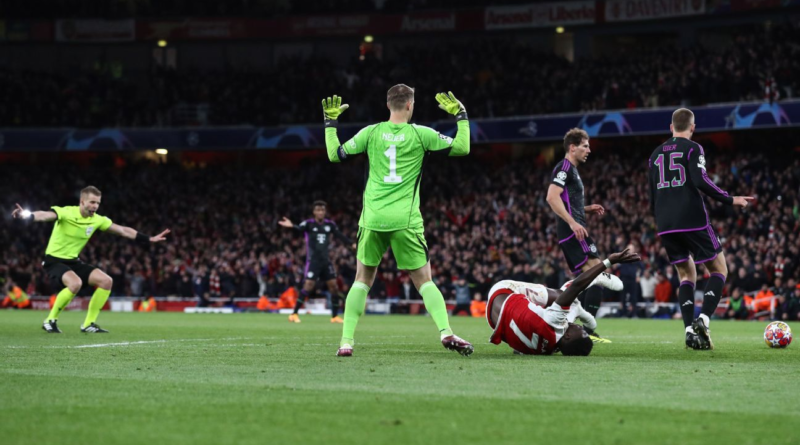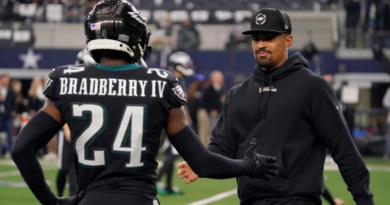The VAR Review: Why Harry Kane escaped a red card and more
Video Assistant Referee causes controversy every week across Europe, and it even crops up in the Champions League, but how are decisions made, and are they correct?
On Tuesday, Arsenal‘s quarterfinal meeting with Bayern Munich had three high-profile incidents. Should Bukayo Saka have been awarded an injury-time penalty for a foul by Manuel Neuer? How did Gabriel get away with picking the ball up inside his own area? And was Harry Kane fortunate to avoid a red card?
We take a look at the major incidents to examine and explain the process both in terms of VAR protocol and the Laws of the Game.
– How VAR decisions have affected every Prem club in 2023-24
– VAR in the Premier League: Ultimate guide
Possible penalty: Foul by Neuer on Saka
What happened: Less than 30 seconds of second-half stoppage time remained when Thomas Partey threaded a ball through the centre to Saka. The England international moved the ball to the left as Neuer came out to close, and the attacker went down claiming a penalty. Swedish referee Glenn Nyberg ignored the appeals as a Bayern defender cleared.
VAR decision: No penalty.
VAR review: There was obvious concern from Neuer and the Bayern Munich defence when Saka went to ground, as there was contact between the two players.
It soon became evident from the replays that Saka initiated the contact by placing his right boot into the knee of the goalkeeper to give the impression he had been fouled.
This is not the same as a player accepting contact from a challenge, as was the case with Liverpool‘s Harvey Elliott for the penalty awarded against Manchester United defender Aaron Wan-Bissaka. And, of course, in both situations the decision of the referee was supported by the VAR.
Once the VAR, Dutch referee Pol van Boekel, sees that the attacker has caused the contact there won’t be an overturn.
Would the spot kick have stood if Nyberg had awarded it? Possibly, as Neuer had moved his leg slightly across, but it’s a decision which would have to be made on the field.
Even though it was so close to the final whistle, there could still have been a VAR penalty if a foul had been identified after game had ended. This happened in a game between Brighton & Hove Albion and Manchester United in September 2020, with Neal Maupay penalised for a handball and Bruno Fernandes converting a 100th minute spot kick after referee Chris Kavanagh had blown for full time.
Possible penalty: Handball by Gabriel
What happened: Arsenal had a goal kick in the 66th minute in what appeared to be an innocuous situation. Goalkeeper David Raya had the ball in the centre, with Gabriel to his left on the corner of the six-yard area. Referee Nyberg blew his whistle for the kick to be taken and Raya passed to Gabriel, who picked the ball up and placed it down again before passing it to Raya. Should there have been a penalty awarded for handball?
VAR decision: No penalty.
VAR review: Bayern Munich boss Thomas Tuchel was furious after the game, saying: “He told our players that it is a ‘kid’s mistake’ and he will not give a penalty like this in a quarterfinal. This is a horrible, horrible explanation.”
Was Raya intending to take the goal kick, or was he rolling the ball to Gabriel for him to take? That Raya played the ball in front of his teammate, rather than square to him, would suggest the goalkeeper believed he was restarting the match.
It’s a fascinating situation and there’s no doubt that in law this should have been a penalty — but is it what football would expect? This is where Nyberg has the freedom to not give the spot kick, and in fact he would probably have caused more controversy if he had.
Quite often we’ll see a player alter the position of a free kick after the referee has blown his whistle, rolling the ball to a teammate who picks up the ball and positions it, or puts a hand on it to stop it rolling. Do we really expect a referee to switch the free kick to the opposition in such circumstances? And if not, why would a penalty be any different? It’s not as if Gabriel gains anything from picking up the ball and passing it to Raya.
It’s complicated by the referee having his back turned as Gabriel picks up the ball. However, it’s likely he was informed of the events by the rest of the officiating team, as when the ball goes to Raya the referee has turned around and again blows his whistle.
Tuchel was particularly annoyed that Nyberg wouldn’t give the spot kick because it was such a big game, yet it’s clear that the referee had made a decision and explained that to the players. Rightly or wrongly he has determined the restart should be taken again, and in those circumstances the VAR isn’t going to tell the referee he’s got it wrong.
In the early days of VAR there were some notable situations where, according to the IFAB, interventions happened against the spirit of the protocol. Perhaps the most infamous example came in the 2. Bundesliga fixture between Holstein Kiel and VfL Bochum in October 2019 when a substitute conceded a penalty.
Kiel’s Michael Eberwein was warming up behind the goal when Bochum’s Silvere Ganvoula M’boussy dragged a shot wide. Eberwein touched the ball before the whole of the ball had left the field of play, and the VAR intervened to give a penalty to Bochum. In law that was the correct decision, but the IFAB insisted VAR was not intended to penalise such a minor infraction.
Obviously that incident involved a player who wasn’t involved in the game while Gabriel was on the field, yet it gives an impression of how the IFAB views infringements which might be correct in law but perhaps not in the spirit of the game — as far as VAR’s remit is concerned.
Possible red card: Violent conduct by Kane
What happened: The game was in the 55th minute when Kane backed into Gabriel, with the Arsenal defender going down clutching his face. Kane was booked by the referee, but was there a case for a red card for the Bayern Munich striker for throwing an elbow into an opponent?
VAR decision: No red card.
VAR review: Kane takes a look over his shoulder as he waits to try to collect an aerial ball. His arm then connects with Gabriel as he backs in to hold the defender off.
Was Kane checking where Gabriel was to work out the space, or to place his elbow into him? Only Kane himself will know his true intentions.
As always, key to the decision will be what the referee says to the VAR. He has seen the contact on Gabriel as he’s booked Kane, so if the VAR determines there has been no throw of the elbow then a caution would be an acceptable on-field decision.
VAR officials look for a clenched fist as one of several indicators of an aggressive act, and Kane’s hand is fully open as he backs into Gabriel. This isn’t the only factor, but it’s something referees use to distinguish between violent conduct and a normal football action.




